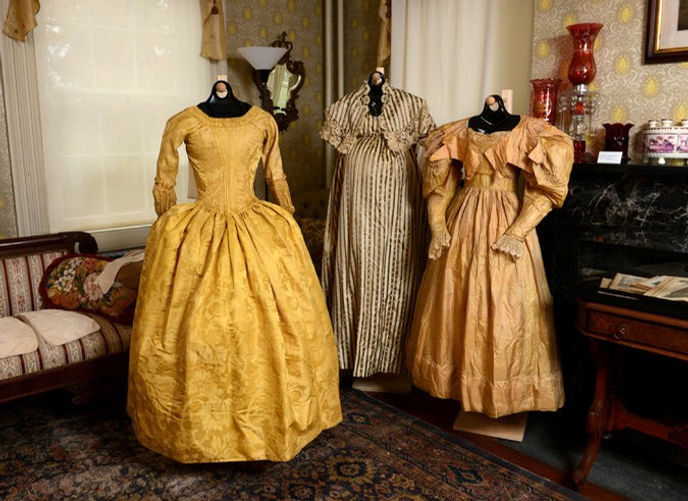
America in Handbags and Glad Rags
By AILEEN JACOBSON DEC. 18, 2015

A 1780s gold silk damask evening dress, left, a striped silk brocade maternity dress from the 1790s,
center, and a gold silk taffeta dress from the 1820s. Credit Kathy Kmonicek for The New York Times
Abraham Lincoln, John Philip Sousa and the fictional Jay Gatsby are the marquee names at “Costume and Culture: Our Heritage, Our Fashion,” an exhibition in Port Washington.
However, the clothing worn by more ordinary people — gowns and suits, bustles and top hats, pantalets and bathing suits — fills most of the nine galleries in the historic Sands-Willets House, now a museum run by the Cow Neck Peninsula Historical Society. The hundreds of items on display, including accessories like parasols, corsets and men’s collars, trace the changing mores of the United States through the evolution of its fashion trends.
“We kept finding things that we had to show,” said Joan DeMeo Lager, the historical society’s curatorial administrator and the curator of the exhibition. “It kept growing and growing.”
Several dresses that would have been worn with a dozen or so petticoats are not spread as wide in the show, Ms. Lager said, so more could fit into the rooms. Ms. Lager’s extensive research is reflected in the script she wrote for the museum docents.

John Philip Sousa's parade coat from the early 1900s. Credit Kathy Kmonicek for The New York Times
As Ms. Lager researched domestic habits related to a circa-1860 nightshirt on display in the rear parlor, she looked back to the 1600s and learned that women and men “rose in the morning and added their clothing to their sleepwear,” she said. “They would reverse the process at nighttime.”
Clothing was washed only rarely, though more frequently if made of linen, as were aprons and underclothes. “And that would be every six weeks or so,” she said. Bathing was thought to be unhealthy until the middle of the 1850s.
The exhibition’s three oldest dresses are also shown in the rear parlor: a 1780s English import, a 1790s Empire-style maternity dress and an 1820s gold silk taffeta. Accessories there include late-1700s women’s pockets, which were fabric pouches tied over a woman’s many underclothes and could be reached via slits in the outer skirts.
They often contained smelling salts, Ms. Lager explained. These were needed as women frequently fainted because of their heavy petticoats and tightly laced corsets, which were painful and could lead over time to deformities and even death.
When metal hoops arrived, around 1850, a skirt could measure four yards around. Women welcomed them, Ms. Lager said, because they were lighter than petticoats, though they required their wearers to sit on the floor in carriages rather than on the benches, and sometimes caught fire when near a fireplace.

Hoop skirts led to the birth of undergarments (underwear) for women, in case a hoop swung up. Because women couldn’t reach beneath their hoops to pull their drawers down, the underwear, known as pantalets, had no crotch. Examples of the early underwear are on display in an upstairs bedroom.
Clothing changed in response to wars, including the Civil War and World War I, when women were forced to do more strenuous work because men were away fighting, and resources like the metal for hoops were needed to make weapons.
The invention of the sewing machine in 1846 and other developments, like the advent of paper dress patterns in 1859, enabled women to make their own clothes or have local seamstresses do the sewing.
“Not all seamstresses were equal,” Ms. Lager said, pointing to a purple dress, part of a group from the 1890s in the front parlor, which has noticeably crooked seams and decorative trim.
The 1890s also saw the introduction of the shirtwaist, a white blouse worn with a dark skirt, which became a uniform for women as they worked, played or attended classes.
-
Exhibition floor plan (printable)


